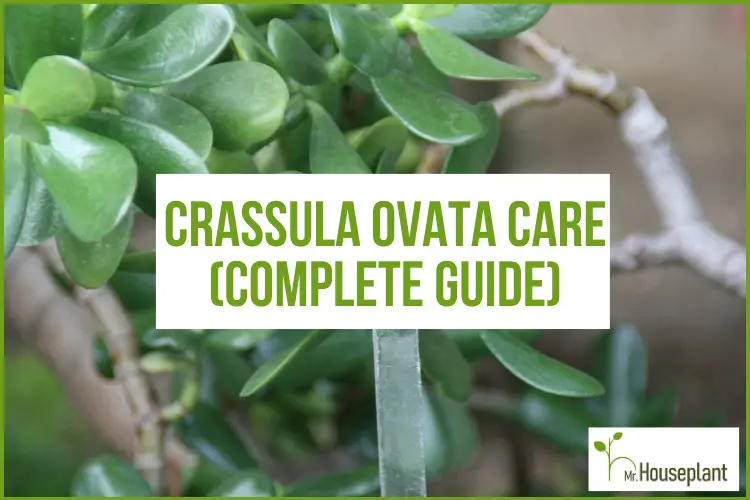
Want to learn about Crassula Ovata care but don’t know where to start? Or do you already have one but you need some extra advice? Then this ultimate Crassula plant care guide is the perfect read for you. Read on to get all the tips and expert advice on light requirements, watering, fertilizing, repotting, propagation and much more.
| Botanical Name (Latin Name/Scientific Name): | Crassula Ovata |
| Common Name: | Jade Plant, money plant |
| Light: | Full sun |
| Watering: | when the soil dries out to the bottom of the pot |
| Soil: | succulent or cacti mix |
| Repotting: | Once a year |
| Fertilizing: | once every 2-4 weeks with a succulent fertilizer |
| Temperature: | Optimal 18 to 24 C° (65 to 75 F°) |
| Humidity: | optimal 25% to 50%, but adapts well to any humidity level |
| Toxicity for Pets: | Toxic to cats and dogs (nausea, vomiting, diarrhea) |
| Toxicity for Humans: | Toxic to humans (vomiting, diarrhea, depression, ataxia, and slow heart rate) |
| Propagation: | Leaf cutting in water, leaf cutting in soil, stem cutting in water, stem cutting in soil and division |
Crassula Ovata are succulent plants with deep green leaves that originate from South Africa. They are often called Jade plants or money tree. They were previously classified as Crassula portulaca and Crassula Obliqua. They have thick, fleshy leaves. They are a medium maintenance plant. If cared for well, they can grow star shaped flowers, white flowers.
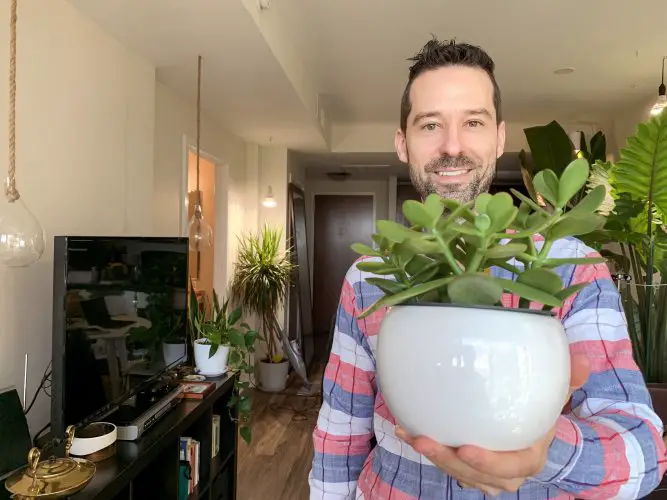
Mr. Houseplant with his beautiful Jade Plant
Crassula Ovata Care
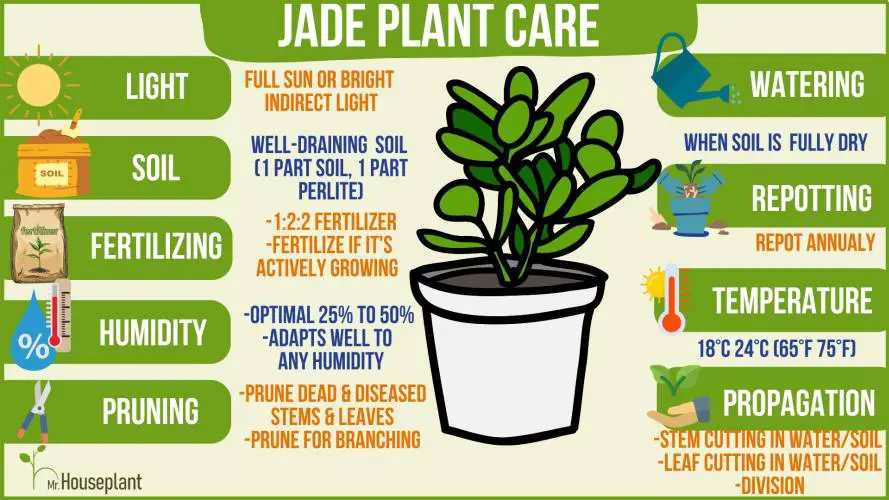
Jade Plant Care includes proper light, watering, soil, repotting, fertilizing, temperature, humidity, pruning and propagation
Light Requirements
| Minimal amount of light: | 3,000 lux (300 FC) |
| Optimal amount of light: | 5,000+ lux (500+ FC) |
| Direct sun tolerance: | 8 hours |
| Category: | Full sun |
Crassula Ovata Jade plant is a full sun plant and prefers direct sunlight, it can also grow well in bright light/bright indirect light with a minimum of 3,000 lux (300 foot candles). If you can’t provide these light levels, Crassula can survive even in lower light, as low as 3,000 lux (300 foot candles). The more light you provide, the happier your plant will be. More light enhances photosynthesis and makes the plant more resistant to pests and diseases.
Do Jade Plants Need A Lot Of Sunlight?
Yes, Jade needs a lot of light – 8 or more hours of direct sunlight would be perfect. But the plant do well if it’s getting at least bright indirect light of over 3,000 lux (300 foot candles)
Can A Jade Plant Get Subnurned?
Yes, a Jade plant can get sunburned if it’s not gradually acclimated to direct sunlight. When exposing your jade plant to direct sun, make sure to do it gradually – give it one hour of early morning direct sunlight for 1 week before increasing by 2 hours of direct sunlight each following week, until it starts spending most of the day in direct sun.
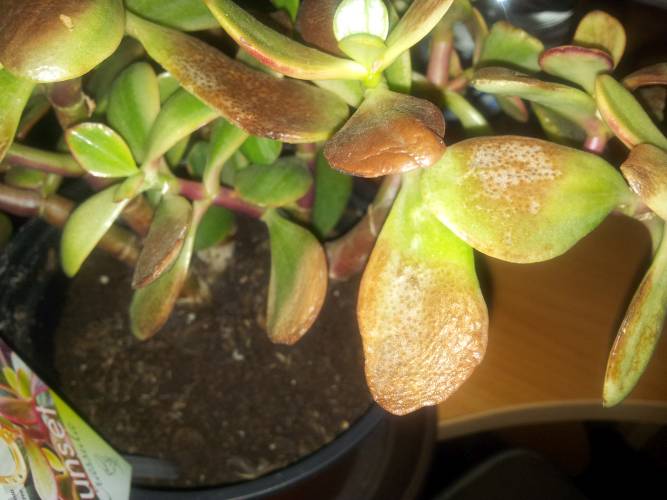
Sunburned Jade Plant
Watering
Water Jade plant once the soil is fully dry, all the way to the bottom of the pot. To check the soil, stick a chopstick inside it, push it gently all the way down, and pull it out. If the chopstick comes out dry, with no soil attached to it, it’s time to water. If the chopstick comes out wet or dirty, with soil attached, this means the soil is still wet and you should hold off with watering. If you’re unsure, wait another week. With a Crassula plant, it’s always better to go on the side of underwatering. They are drought-tolerant and can survive even a few weeks without water if needed.
Jade Plant Humidity
The optimal humidity for Jade plant is between 25% and 50%. However, the plant adapts well to any humidity level. Even if the humidity in your home is over 70%, or below 20%, your plant will do just fine.
Jade Plant Temperature Needs
The optimal temperature for Jade plants is between 18 to 24 C° (65 to 75 F°).
Fertilizing
Fertilize Jade Plants with a low-nitrogen succulent fertilizer once every 2 to 4 weeks. When fertilizing, make sure to follow the instructions on the fertilizer packaging and do not use more fertilizer than listed on the packaging.
An excellent succulent fertilizer is Espoma Succulent and Cacti Fertilizer. It is a low-nitrogen fertilizer with an N-P-K ratio of 1-2-2.
Please note that fertilizing Crassula Ovata is not necessary if you repot the plant annually. By repotting annually, new soil will provide your plant with nutrients.
Never fertilize a plant if it’s not growing. Since the plant won’t be able to use the nutrients, they will accumulate in the soil. And over time, they can burn the roots and damage the plant.
Soil
The best soil for Jade plants is soil that dries out quickly between waterings. This type of soil is called well-draining soil. You can make a well-draining soil mix by mixing 1 part any store-bought potting mix and 1 part perlite, pumice, or coarse sand.
Store-bought potting mixes in most cases are not well-draining. They retain too much water. This means the soil dries out much slower which increases the chances of root rot. That’s why you need to amend them with perlite, pumice or coarse sand to make them well-draining.
Another disadvantage of store-bought potting mixes is they mostly consist of peat moss or coco coir. Peat moss and coco coir consist of very tiny particles. These particles compact over time. When they get compacted, there isn’t much room for oxygen. And the lack of oxygen is the perfect environment for the development of bacteria or fungi that can cause root rot.
Repotting
To repot the Jade plant follow these steps:
- Take the plant out of its pot
- Lightly loosen the rootball
- Inspect the roots
- Cut off dead, soft, mushy roots, if any
- Fill up 1/3 of the new pot with fresh soil (choose a pot with a drainage hole)
- Place the Jade plant into the new pot
- Fill the pot with soil
- Press the soil lightly around the plant
- Water if the soil has been dry before repotting
Toxicity To Pets
Jade plants are mildly toxic to pets if ingested, according to the American Society For Prevention Of Cruelty To Animals (ASPCA). They aren’t lethal but can cause great discomfort to your furry friend. The usual symptoms are vomiting, depression and incoordination. So, unfortunately, Jade plant isn’t a pet-friendly plant.
Toxicity To Humans
Crassula Ovata plants are toxic to humans when ingested and can cause problems such as vomiting, diarrhea, depression, ataxia, and slow heart rate, according to Ann King Filmer, Ph.D. Plant Scientist from the University of California, in the publication “Safe and Poisonous Garden Plants” from October 2012. If ingested, call the Poison Control Center or your doctor. Jade plants can also cause dermatitis – skin rash or irritation.
Pruning
Healthy Jade plants don’t need to be pruned. Only prune dead or diseased growth or if you want to take a cutting for propagation.
Propagation
You can propagate Crassula Ovata through leaf or stem cuttings in water or soil, and division. Continue reading for details on different propagation methods.
Leaf Cutting In Water
To propagate a Jade Plant through leaf cuttings in water follow these steps:
- Pull off a whole leaf (or better yet several leaves)
- Place the leaves in a propagation dish with water so that the part previously attached to the stem is under water
- Put the propagation dish in bright indirect light (over 5,000 lux)
- Replace water weekly to replenish oxygen and remove harmful bacteria
- Once the leaves grow 2-3 inches of roots, pot them in the soil
- In soil, water once the soil is 100% dry
- In a few months, you should see new leaves growing
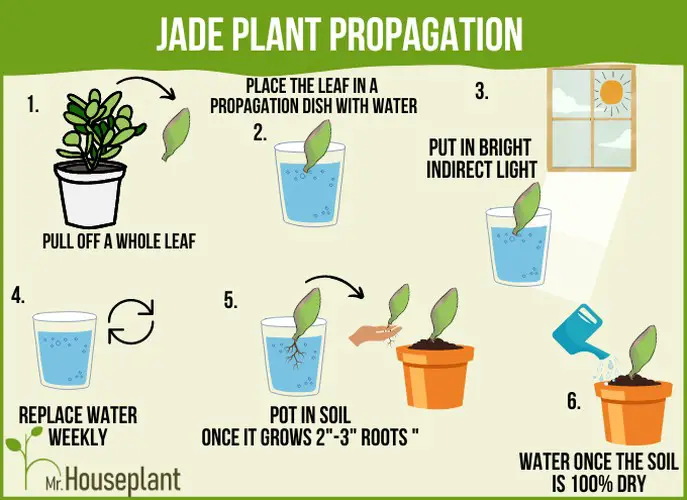
Follow these six steps for successful propagation
Using a heat mat will increase the temperature of the water and speed up propagation. An air pump will provide oxygen for new roots. It will also cut the propagation time in half and reduce the need to replace water frequently.
Leaf Cuttings In Soil
To propagate a Crassula Ovata through leaf cuttings in soil follow these steps:
- Pull off a whole leaf (or better yet several leaves)
- Fill a shallow pot with a well-draining soil mix (1 part soil, 1 part perlite)
- Pot the cut leaves in the pot. Make sure the side previously attached to the stem is under soil
- Put the pot in a warm spot with bright light (over 5,000 lux)
- Water once the soil is 100% dry
- If the soil stays wet longer than a few days, increase light and repot to a terracotta pot
- In a few weeks, the leaves should root, and in a few months, they should grow new leaves
Stem Cuttings in Water
Here is a video of Jade plant stem cutting propagation in water:
Division
If your Jade plant has more than 1 stem in the pot, you can propagate it through division. Division is separating two stems at the root level and potting them individually. By doing this, you will get two separate plants. To propagate a Jade plant through division, follow these steps:
- Take the plant out of the pot
- Remove soil to expose the roots
- Take a sterilized knife
- See where the two stems are connected. Cut the roots in between the two plants.
- Pot the stems in individual pots
Pests
Most common pests on Jade plants are aphids, spider mites and mealybugs. The best way to treat against pests is by using horticultural oil, insecticidal soaps or neem oil.
Common Problems with Crassula Ovata
White Spots On Leaves
White spots on the leaves of Jade plants are excess salts that are pushed out through the leaves. They are normal and not a reason for concern.
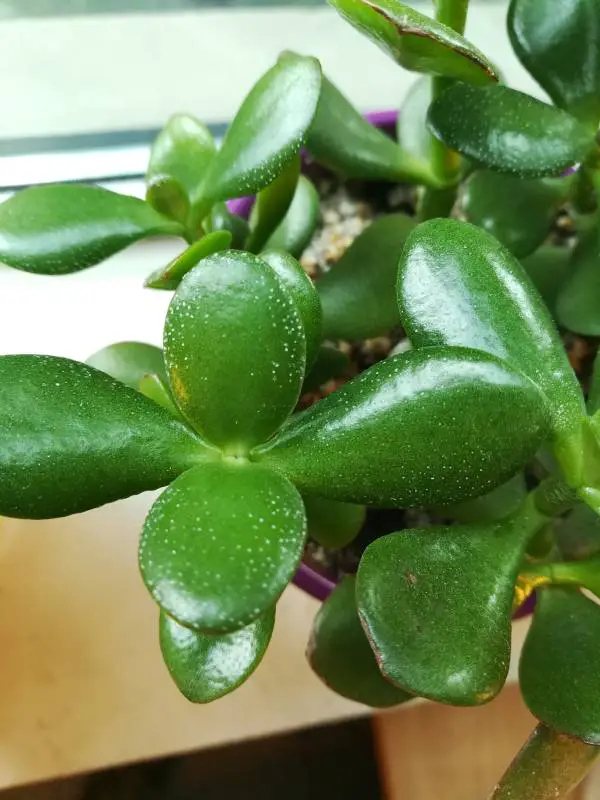
White spots on jade plant leaves are normal. This is a healthy plant.
Shriveled Leaves
Shriveled leaves are usually caused by underwatering. Water the plant, make sure the soil is fully saturated. After a day or two, the leaves should return to normal.
Soft and mushy leaves
Soft and mushy leaves are usually a sign of root rot caused by overwatering. If your plant has soft and mushy leaves, take it out of the pot. Remove all soil and cut off all soft and mushy roots. Repot in a fresh well-drained potting mix. And place the plant in the brightest spot in your home.
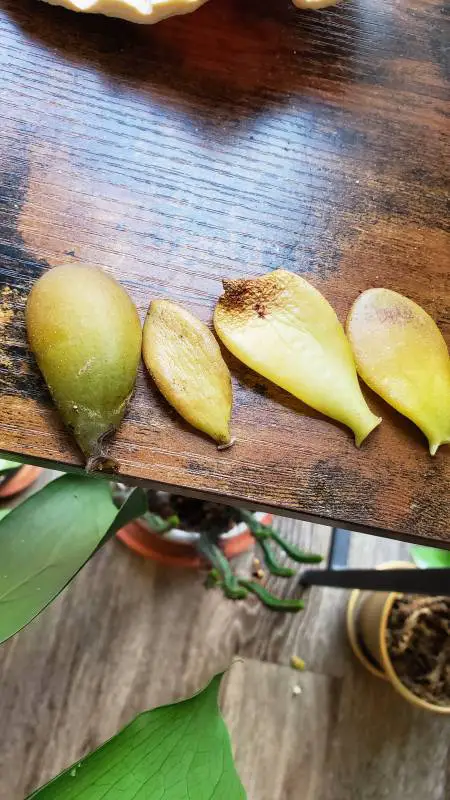
Yellow mushy leaves that have fallen off
Types Of Crassula
There is a wide array of crassula species and cultivars available to choose from. Alongside the typical jade plant cultivars (Crassula ovata), there are various other options worth considering:
- Crassula ‘Morgan’s Beauty’: A hybrid cultivar with silver leaves that have white dusting and attractive pink flowers in late spring. It grows up to 4 inches tall.
- Crassula erosula ‘Campfire’: This variety has lime leaves that branch out and turn bright red in winter. It is a clumping plant that can grow up to 8 inches tall and spread up to 3 feet wide.
- Crassula pellucida variegata: This plant has heart-shaped leaves that are variegated with pink, green, and creamy yellow
- Crassula perforata: This species, also known as the stacked crassula or string of buttons, has leaves that form a circle around a central stem.
- Crassula arborescens: This species, also called Chinese jade or silver dollar jade, has rounded blue-gray leaves with maroon edges and can grow up to 4 feet tall.
- Crassula muscosa: This species is sometimes referred to as watch chain, rattail crassula, or zipper plant. It has small light green leaves that give the stems a rough, corrugated look.
- Crassula capitella: This species has multiple subspecies with green leaves that turn reddish in sunlight. They are typically small and biennial, and not commonly grown as houseplants.
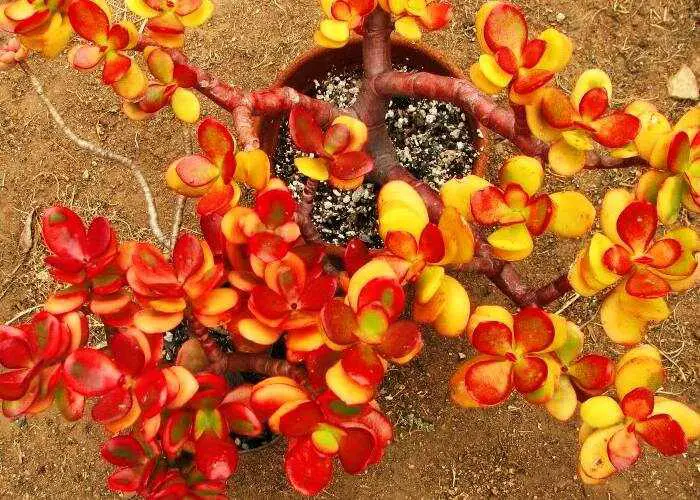
A Jade plant that changes color when exposed to direct sunlight
FAQ
How Long Can a Crassula Plant Live?
A Crassula plant can live from 20 to over 100 years. long time and reach heights of three feet or more if they are grown indoors.
How Can I Identify Which Crassula Plant I have?
The easiest way to identify which Crassula Plant you have is by looking at the shape and pattern of the leaves
More Questions on Jade Plant Care?
If you have more questions on Crassula Ovata care or other house plants, schedule a talk with me. I’m always happy to help!
Yours Truly,

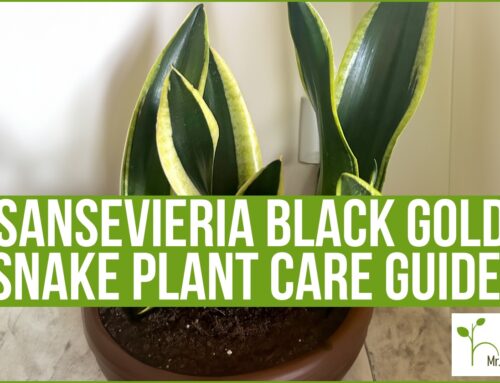

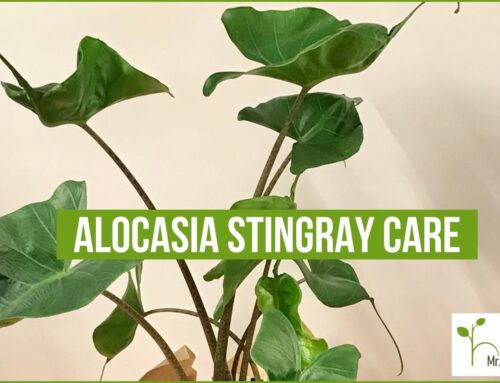


Great information. As a suggestion, do you think you could you share information about dormancy periods for plants, which is very helpful for fertilizing and frequency of watering?
Hi Louise, thank you for an excellent suggestion! I will start adding this section to my blog posts. A lot of houseplants will not go dormant during autumn and winter if we provide them with sufficient light (and warmth, but warmth is already there indoors all year round). Some will though, so I’ll start adding this information to my blog posts.